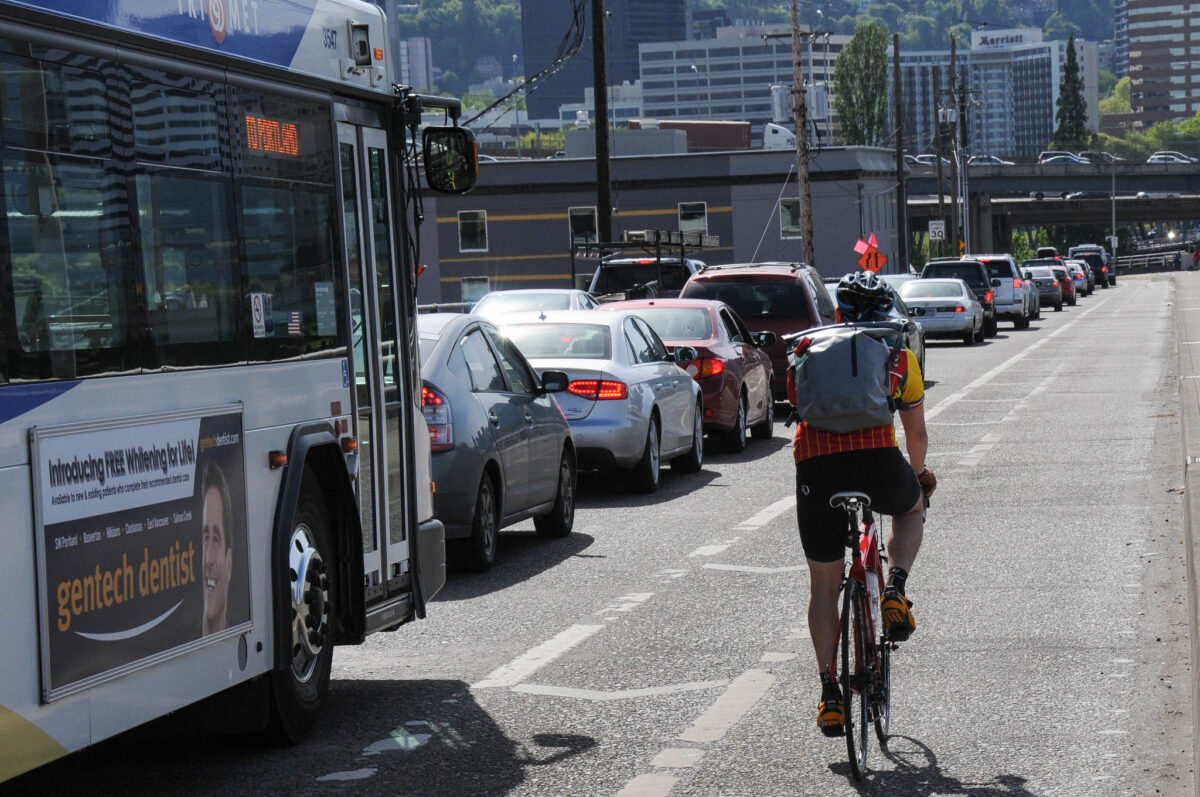
(Photo: Jonathan Maus)
When the Portland Bureau of Transportation (or any government agency for that matter) doesn’t have the public and/or political will to do something they know needs to be done, they will often create a plan. Once adopted, plans give the agency the foundation of policy and information needed to bolster their case both internally and externally. Such is the case with their Enhanced Transit Corridors Plan, which is now complete and headed to City Council for adoption on June 20th.
“If you want to move across the city while taking only your fair share of scarce street space, there are two ways to do it: 1. Use a vehicle that’s not much bigger than your body, like a bicycle. 2. Share a vehicle with lots of other people, like transit.”
— from the executive summary
Last month we shared PBOT’s new guidebook on protected bike lane designs that will help its engineers and planners build more of them. On Monday we shared the Bureau of Transportation’s plans to hasten the development of streets with dedicated space for bicycling. And today PBOT has released the final version of its Enhanced Transit Corridors Plan, which we covered in more detail back in March.
Like the Central City in Motion plan, the Enhanced Transit Corridors Plan (ETC) seeks to codify PBOT’s intentions to make significant changes to our streets. These plans take on extra significance because the future they envision — more space for cycling and buses — will lead to less space for driving. This required change is such a dramatic shift that PBOT put extra effort into the narrative framing of the ETC Plan. In fact, they hired noted transit expert Jarrett Walker to write the executive summary.
Here’s the prologue, which comes after a page with the words, “Portland faces a crisis of freedom and opportunity,” in all caps (emphasis theirs):
Freedom means freedom to choose. We want to choose our careers, schools,friends, groups to belong to, and places to shop. You can also use the word opportunity to describe those same things.
But we have choices and opportunities only if we can get to them. Our crisis is that the places we need and want to go to are becoming harder to reach.
The city is growing denser, and density means more people trying to travel down every major street.
But the space available for travel can’t grow with population. The options for expanding travel space – widening roads or building tunnels and viaducts – cost a fortune and sometimes damage our city. Mostly we have to get better at sharing the space we have.
Advertisement
The summary then spells out the basic math that too much single-occupancy driving simply doesn’t fit in Portland (both figuratively and literally). One of my favorite passages asks, “So how can we share space?” and then says, “If you want to move across the city while taking only your fair share of scarce street space, there are two ways to do it: 1. Use a vehicle that’s not much bigger than your body, like a bicycle. 2. Share a vehicle with lots of other people, like transit.”
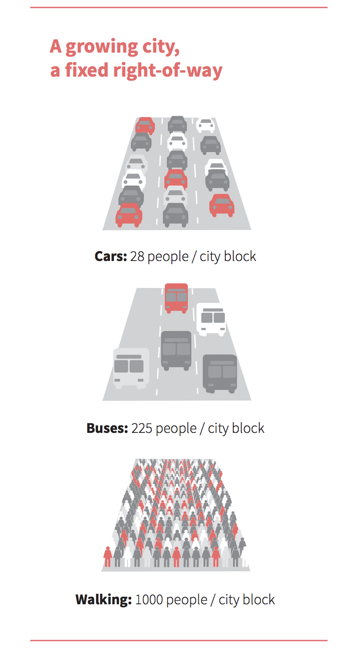
I love this direct talk. Finally PBOT is not beating around the bush when it comes to the truth about driving’s impact on all Portlanders. The storytelling in the ETC plan is great, and storytelling will be an increasingly crucial part of PBOT’s job as we push forward into peeling people’s hands off their steering wheels.
In this plan, PBOT isn’t only sharing hard truths about how we get around. They offer candid self-reflection about their role in creating the mess we’re in. They accept blame for the two main causes of bus delays. “On traffic congestion and friction, though, the City of Portland must lead. These kinds of delay are caused by street design, traffic signals, and sometimes law enforcement. The City mostly controls these things, so the City must lead in addressing them.”
How will PBOT lead on these issues? The plan is also open and realistic about how hard that will be.
“The street design changes needed to improve speed and reliability have monetary costs, but the real challenge is the impact on other modes of travel and other street uses. Where transit needs more space, it will most likely take space that’s now being used for another purpose, often as traffic lanes, signal time or on-street parking. There are many ways to mitigate these impacts but in most cases, there is no way to avoid them entirely.”
The summary then gets into the City’s modal hierarchy, a.k.a. the “transportation strategy for people movement, which was adopted as policy 9.6 in the 2035 Comprehensive Plan. That hierarchy says when it comes to which modes have the most heft when it comes to making decisions about doling out right-of-way walking comes first. Then cycling, then transit, than various types of shared vehicles like AVs. Single-occupancy cars are at the very bottom.
The ETC Plan isn’t all just a paean to transit and rant against the negative impacts of too much driving, it also has concrete recommendations, a design toolbox, and maps that illustrate exactly where and how Portland can make transit work better. The hard work of actually reducing driving space to make way for better transit is still to come; but this is a start.
And when combined with record amounts of new revenue, a stronger footing for protected bike lanes, and a long list of street projects already in the queue, PBOT is poised to finally get its groove back. Here’s to hoping.
If better transit would impact your life, please consider showing up to City Council on June 20th or sending in written testimony to the Council Clerk at cctestimony@portlandoregon.gov with a cc to etcplan@portlandoregon.gov.
— Jonathan Maus: (503) 706-8804, @jonathan_maus on Twitter and jonathan@bikeportland.org
Never miss a story. Sign-up for the daily BP Headlines email.
BikePortland needs your support.

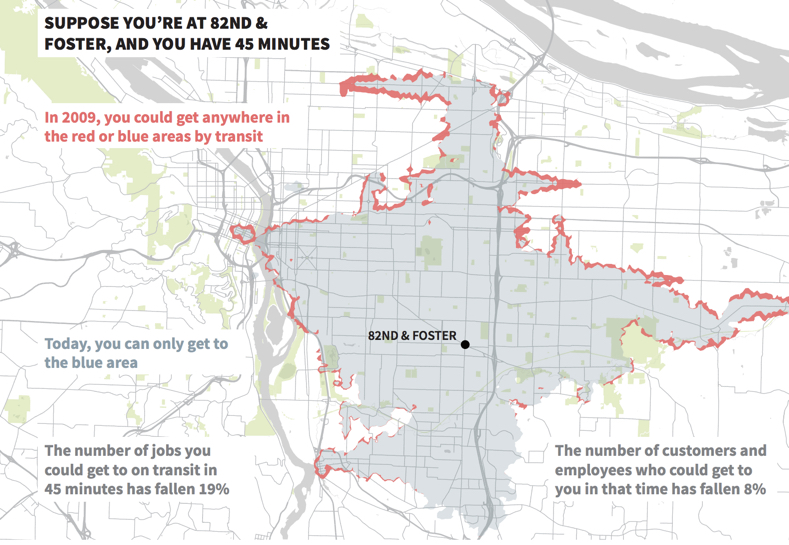
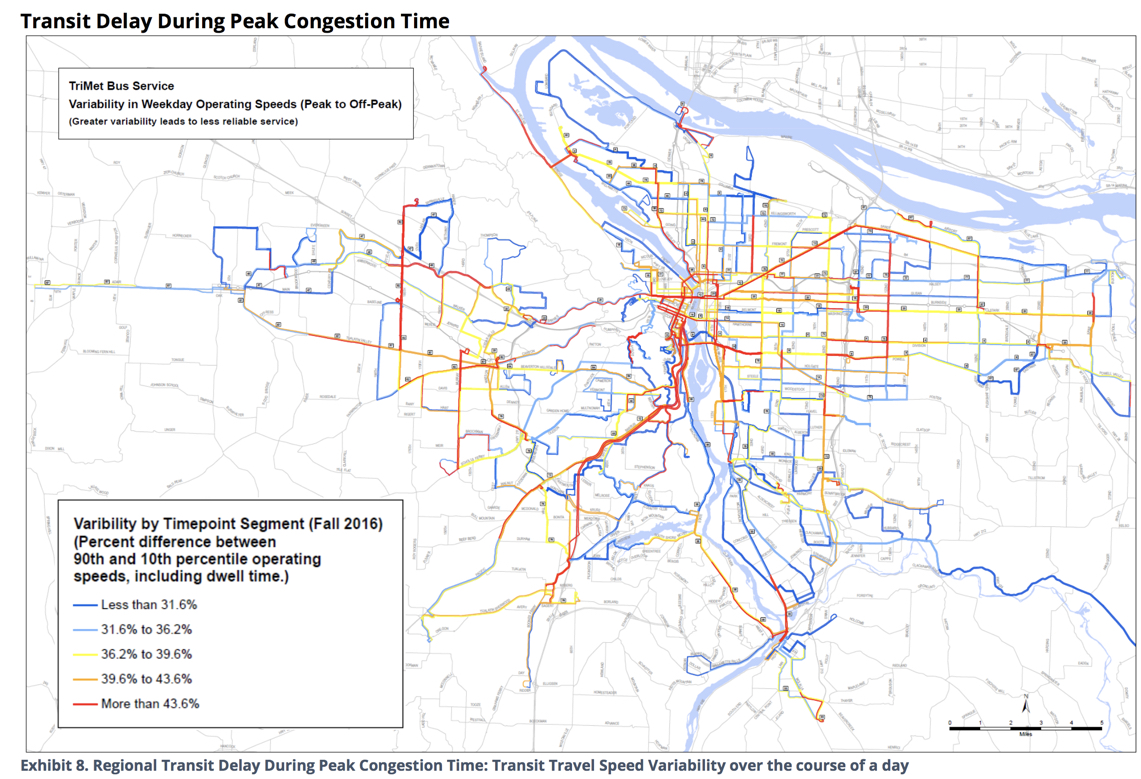
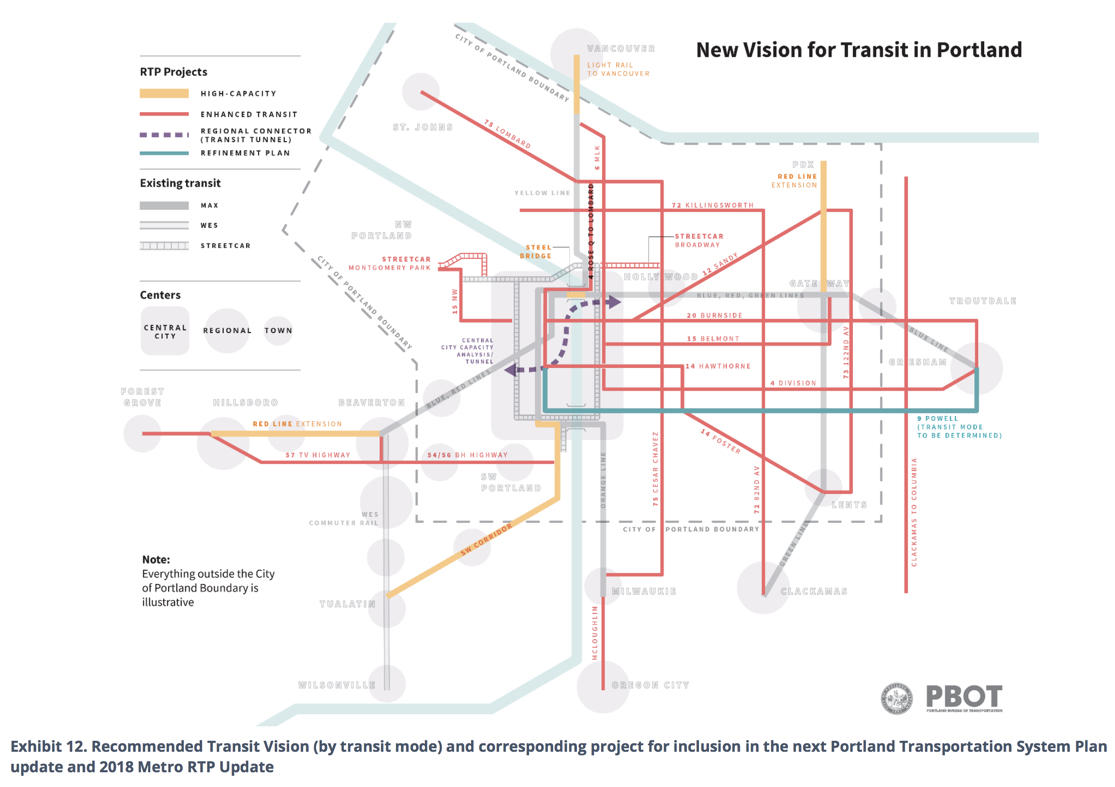
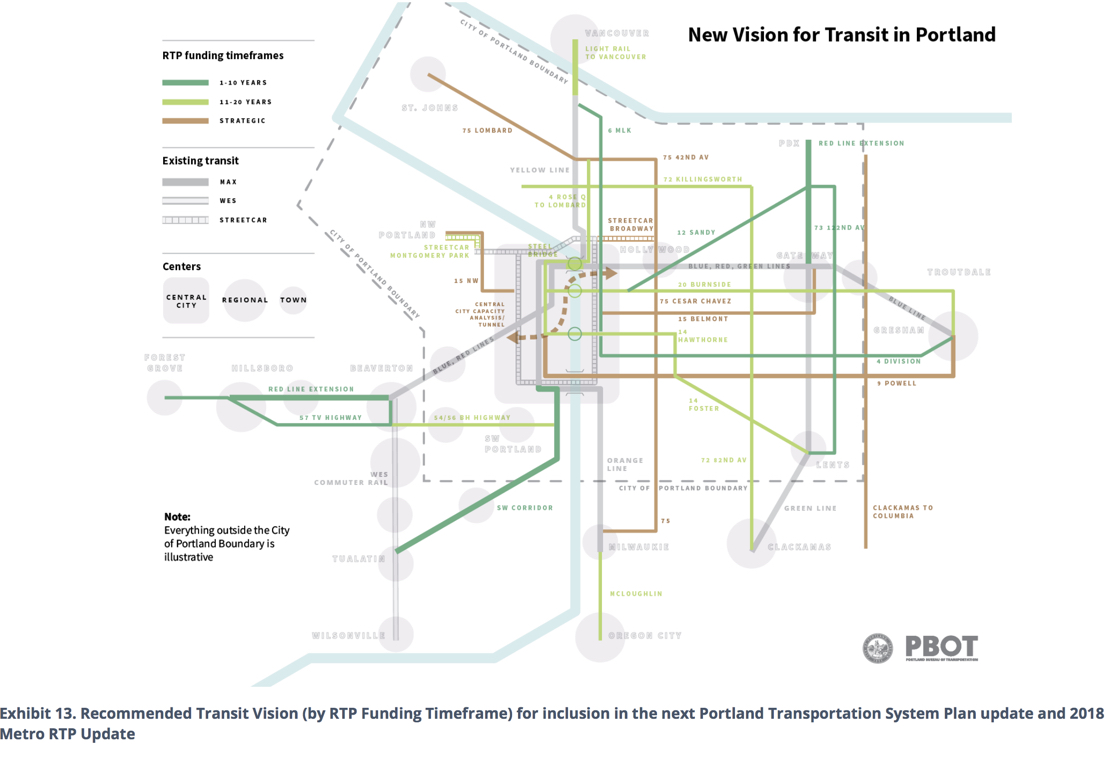


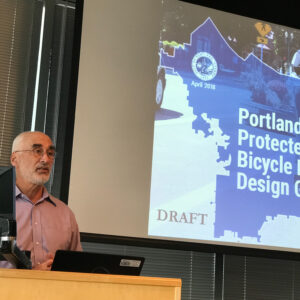
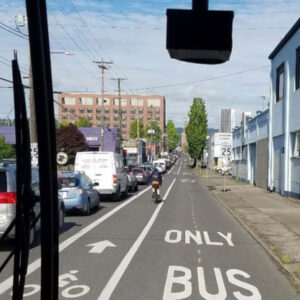
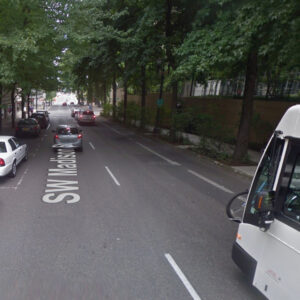
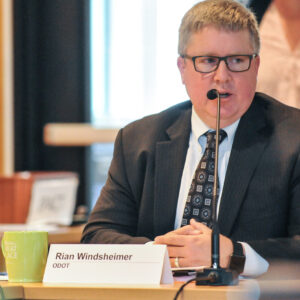
Thanks for reading.
BikePortland has served this community with independent community journalism since 2005. We rely on subscriptions from readers like you to survive. Your financial support is vital in keeping this valuable resource alive and well.
Please subscribe today to strengthen and expand our work.
The map shows that a rebuilt SW Scholls Ferry Road just south of Sylvan could have a bus-only bypass to east-bound SW Canyon Court at Skyline Blvd. Pop-up barricades could prevent motorized vehicles besides TriMet, emergency, and road crews from cutting though there.
Er, great policy and math. But ignores the issue of the inherent differences of getting TO someplace vs. getting through it. I could see central city having so much congestion that most folks wanting to go TO it would use bus, MAX or car share like Lyft. (as has happened to other dense cities on Earth…) But the solution for folks that very, very often are traveling through the city 1. only contribute to the congestion 2. but don’t have any other options. The presence of highways all around/through the central city massively worsens that problem. So, heck shut ALL of the central core to personal cars. But we still need a way to get around that central core in personal cars for kids/work/travel that other transportation options (try as we have) won’t replace.
Those freeways around the city are your solution. The mass transit would travel on surface roads and take people into the city core and out to the neighborhoods. The freeways would allow people to drive around the city a bit quicker without dealing with the traffic and slowdown of being in the city proper.
Of course this requires that we go back to the true ideal of the Eisenhower Interstate System and remove all local access freeway ramps, leaving only those at the far edges of the city open. This ensures drivers aren’t abusing the freeways for local travel, and eases congestion due to the lesser number of on-ramps.
I was excited about this project when it started. Here is the toolbox that published in May 2017, showing the things that PBOT could do to improve transit:
https://www.portlandoregon.gov/transportation/article/640269
And here’s how PBOT was describing what the plan would achieve a year ago:
“The Portland Bureau of Transportation (PBOT) is leading a planning process in coordination with TriMet to develop the Enhanced Transit Corridors (ETC) Plan. This plan will help identify where transit priority, streamlining, and access treatments could be most beneficial on the planned TriMet Frequent Service network bus lines within the City of Portland.” (taken from the June 21, 2017 Open House)
Now that the plan is going to Council we don’t seem any closer to that goal. There are no recommendations that I can find in the plan for where we should be adding any of the transit improvements in the toolbox. The closest to this is an incredibly vague list of projects that Portland could add to the TSP, many of which are 11-20 years out. What those projects might include or how the costs were arrived at isn’t explained.
Seattle has had huge successes in recent years by making targeted investments in their bus network, leading to rising bus ridership. In Portland we’re seeing declining ridership, and I don’t see how this plan even begins to reverse that.
Agree this needs an actual project list. Not much of a plan without projects. Otherwise this just seems like best practices and the same info found in the NACTO guides.
Transit/bike/ped user wants to know how this is going to improve their mobility. The best way to do this is to show potential improvements (projects) regardless if they are funded.
While frustrating, the ball does seem to still be rolling. If you look at chapter 6 of the plan, Metro has dedicated $5 million for further enhanced transit project development.
The diagrams indicate the really bad congestion is really only in a few bottleneck areas, something that mirrors my anecdotal experience.
But the other issue is speed. Transit lanes will help, but more express transit options are needed. Right now, it’s just too dang slow to be a realistic option for many people who have more than a few miles to go. Add in that it’s not nearly as reliable or pleasant as alternatives, and it’s little wonder so many people don’t use it.
Cool! Another plan to go with all the other useless ones drafted at public’s expense lately It will make for good reading when future historians look back at today to try to figure out how it went wrong.
“Hope is not blind optimism. It’s not ignoring the enormity of the task ahead or the roadblocks that stand in our path. It’s not sitting on the sidelines or shirking from a fight. Hope is that thing inside us that insists, despite all evidence to the contrary, that something better awaits us if we have the courage to reach for it, and to work for it, and to fight for it. Hope is the belief that destiny will not be written for us, but by us, by the men and women who are not content to settle for the world as it is, who have the courage to remake the world as it should be.”
-Barack Obama
“When the Portland Bureau of Transportation (or any government agency for that matter) doesn’t have the public and/or political will to do something they know needs to be done, they will often create a plan.”
This is one of the most apt description of Portland’s last decade of transit decisions I’ve read in a while. I have seen so many plans and very little more. At some point is it counterproductive to continue to participate in plans when it appears there are little to no results? What happens if Wheeler and PBOT simply have no one to participate?
Keeps employment at PBOT up!
Indeed, I find it bizarre that TriMet has long-term plans for express service between East Portland and places where they work such as the Columbia Corridor, Clackamas County, Clark County, but that PBOT apparently doesn’t. And what’s with a transit study for outer Powell? Their right-of-way is even narrower than Division and like Division, they also have an aqueduct under the street.
I hope you’ll forgive the pun, but the subway under downtown is a pipe dream. C’mon, Oregon refuses to tax itself, how is it going to afford that???
The idea that they are going to “consolidate” bus stops may work for inner Portland, but it should be a nonstarter in areas like East Portland and County. Our street network, and connectivity already requires long walks to a stop. Walker is full of crap if he thinks “one more block” won’t make a difference.
I think you’re being a bit unfair to Jarrett and PBOT here. The plan clearly says that stop consolidation is good idea where there is already a good street network, not across the board everywhere. For example, from the executive summary:
“People need to have a reasonable walk to a transit stop, but asking people to walk a block further, especially in walkable areas with a good street grid, gets them (and everyone else) faster service.
Kem, no amount of transit priority or station amenities are going to make the east Portland transit experience better if the bus has to stop every several hundred feet. It will never travel far enough fast enough. If you want transit to continue to only be relevant to those who have few other options while still being a poor option for those who use it and condemn east Portland to wallow in its perilous automobility, continue to pursue your absolutely no stop consolidation agenda.
Also, if the walk to the stop is already long, an extra block is a relatively less significant imposition on a pedestrian than elsewhere in the city.
Really happy to see a tunnel as part of the recommended plan. The day that I can ride a blue line subway through downtown bypassing cars blocking tracks and pedestrians darting across the street will be a happy day indeed. I sincerely hope they invest enough money in it to make a grand central station with tunnel connections to points of interest in the city core.
“Transit delay during peak congestion time”
I’m seeing that a lot of these red lines are on streets with 2 lanes in each direction. Why have they not converted one of the lanes to transit-only? This seems like an easy win for transit congestion.
Also, why aren’t they focusing traffic law enforcement on those areas during commute? There are a lot of drivers doing illegal things that slow down transit (in addition to everything else they cause).
New vision for transit on SE Foster? I hate to break it to them, but they missed that opportunity when they said the cars could keep all the space after the Streetscape is done. Are they going to reconfigure the street again? Because now they can’t enhance the transit on Foster without taking away a lot of parking.